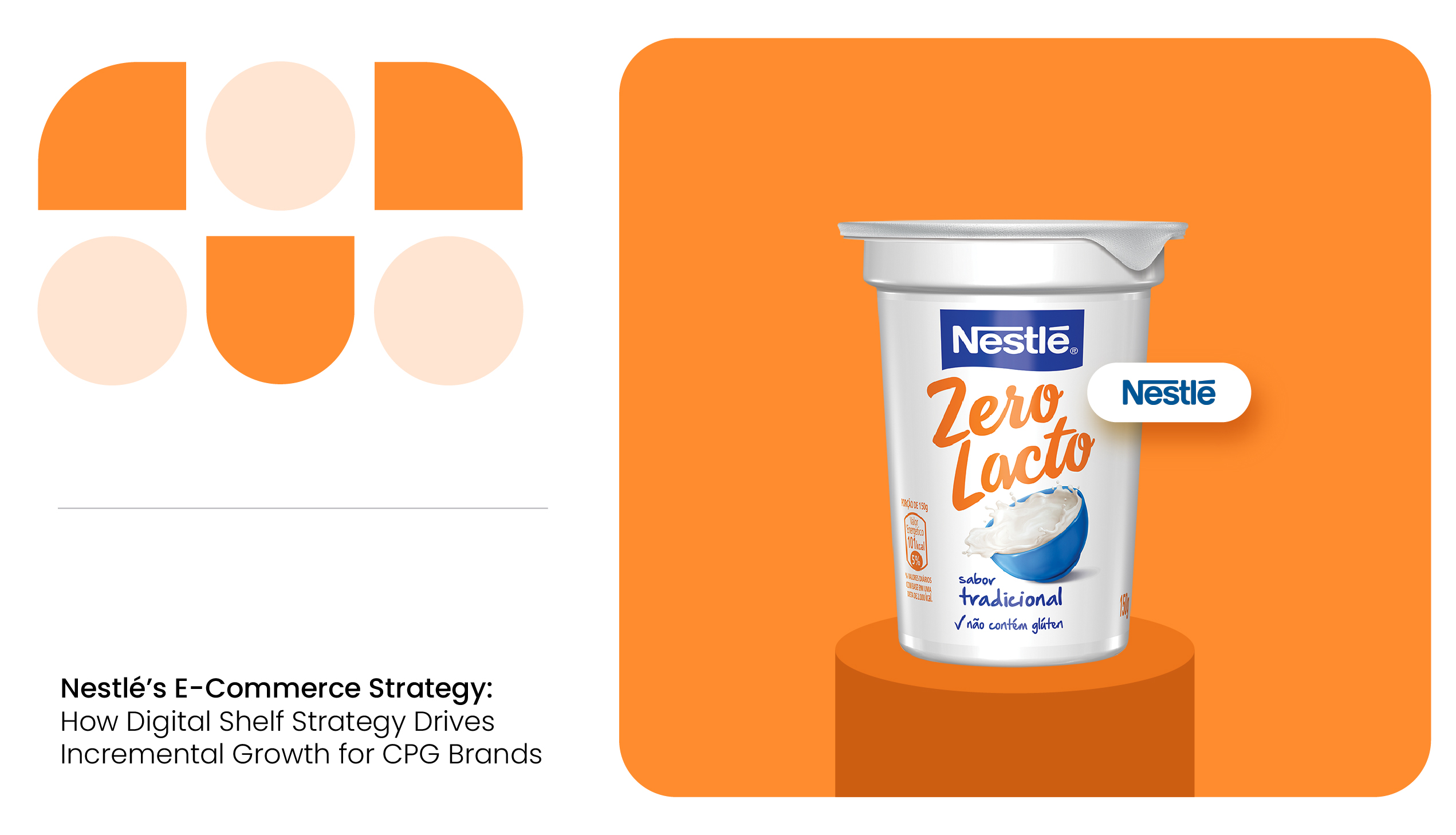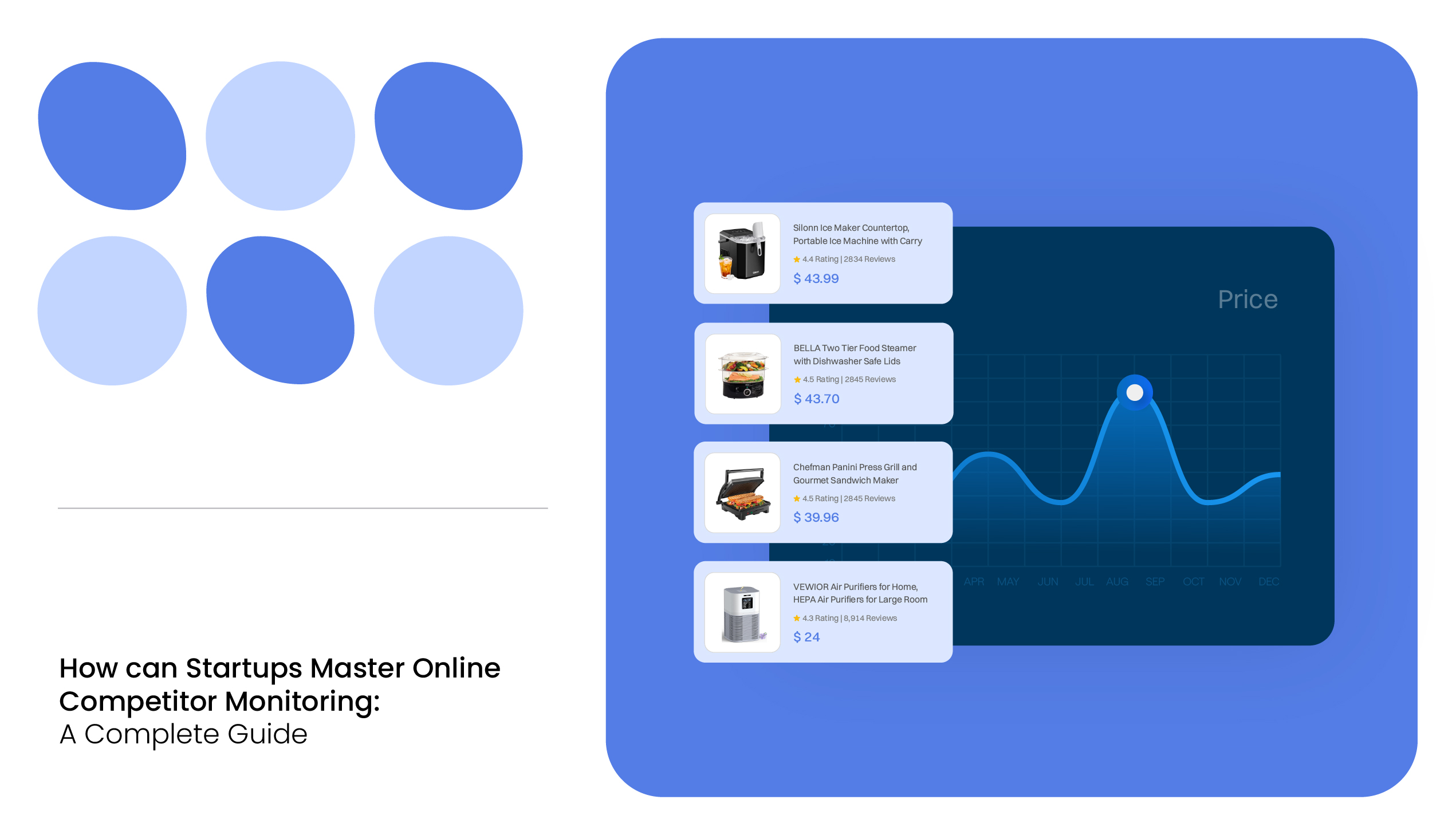Whether you are a digitally native brand, a national brand, or a retail brand, your main goal while selling on Amazon is to maximize profitability and improve online visibility. However, this involves understanding the selling model that best fits your business.
In this article, we’ll explore the key differences between Amazon 1P and 3P, the pros and cons, and even a hybrid selling approach in detail.
What is Amazon 1P?
A first-party (1P) Amazon seller is one who sells their products directly to Amazon. As a retailer, Amazon then sells those products to customers. In short, this means the first-party seller is the vendor and Amazon is the customer.
Amazon’s 1P model follows a traditional two-tier distribution system:
- The vendor’s role is to fulfill purchase orders (PO) that are sent by Amazon on a weekly basis. The items are then shipped to Amazon.
- Thereafter, Amazon does the product pricing on the marketplace, selling and shipping it to customers.
All these business processes are executed through the Vendor Central portal. In a 1P sales approach, Amazon must directly invite you.
How Does Amazon Vendor Central Work?
Amazon Vendor Central is the portal where the vendors manage product information and access purchase orders. The dashboard also helps vendors gain data insights on payment, merchandising, advertising, and reporting.
The process begins when Amazon sends email invites to businesses. Amazon sends invites to different types of businesses, including:
- Existing brands with a strong track record of demand from Amazon shoppers
- Marketplace sellers or third-party sellers doing exceptionally well with their own products
- Sellers at trade shows and fairs with attractive products
If the business is interested in becoming a vendor, Amazon explains the terms of business on Vendor Central. There is usually no room for negotiation except if it is a large-scale brand or there is a vendor manager assigned.
Once the terms are agreed upon, Amazon creates an account on Vendor Central and sends out further information. The vendor can then start updating the product and cost information on the dashboard.
Global Amazon Vendor Survey states that process automation, launching exclusive Amazon products, and setting a hybrid seller approach are the biggest focus areas among 1P vendors.
How To Identify Amazon 1P?
Products sold via 1P will have a “Ships from” and “sold by” Amazon.com label on the brand’s product detail page.
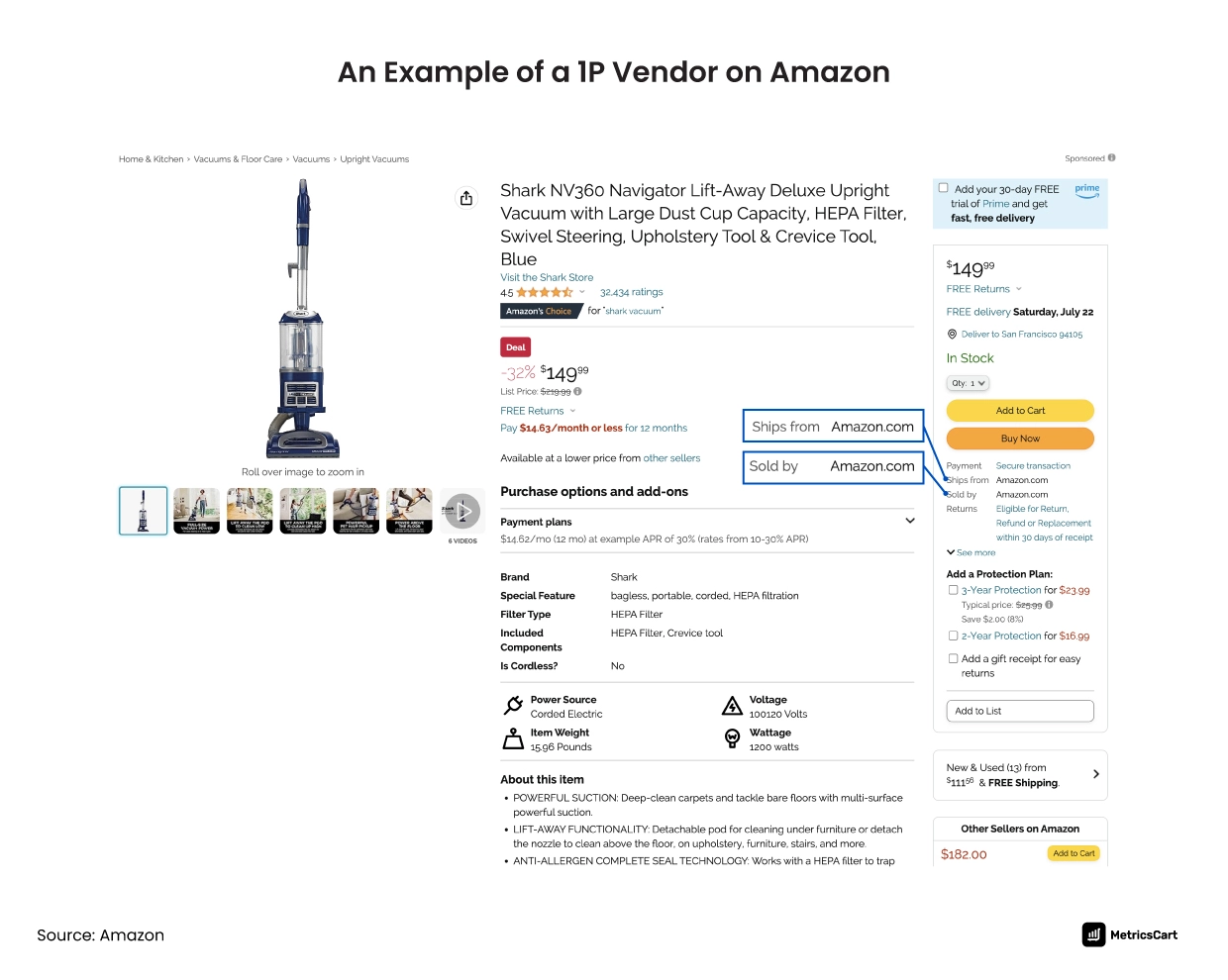
Additionally, Amazon’s US Congress Antitrust Response mentions that if it: a) is a national brand, b) supplies your products to other major retailers, and c) has a long-term vendor relationship with Amazon, the chance of becoming a seller on the marketplace is slim.

For instance, Purina, the pet food brand by Nestle as a first-party seller on Amazon sells Dry Dog Food at a wholesale price of less than $10 different from the retail price. In this way, Amazon offers the customer the best price relative to other big-box retailers. It also reinforces that low price by making 3P merchants of the same brand compete to win the Buy Box (where the seller that offers the best price and shipping package for the item is the default seller).
As per MetricsCart’s Amazon Bestseller Report for the month of May, this product is one of the top-selling products of Purina One.
Read more: An extensive guide on Amazon Buy Box
How Much of a Vendor’s Total Sales Comes From Amazon?
The Global Amazon Vendor Survey states that when vendors come into an agreement with Amazon, only 3.3% of the vendors have more than 75% of their share of sales from Amazon.
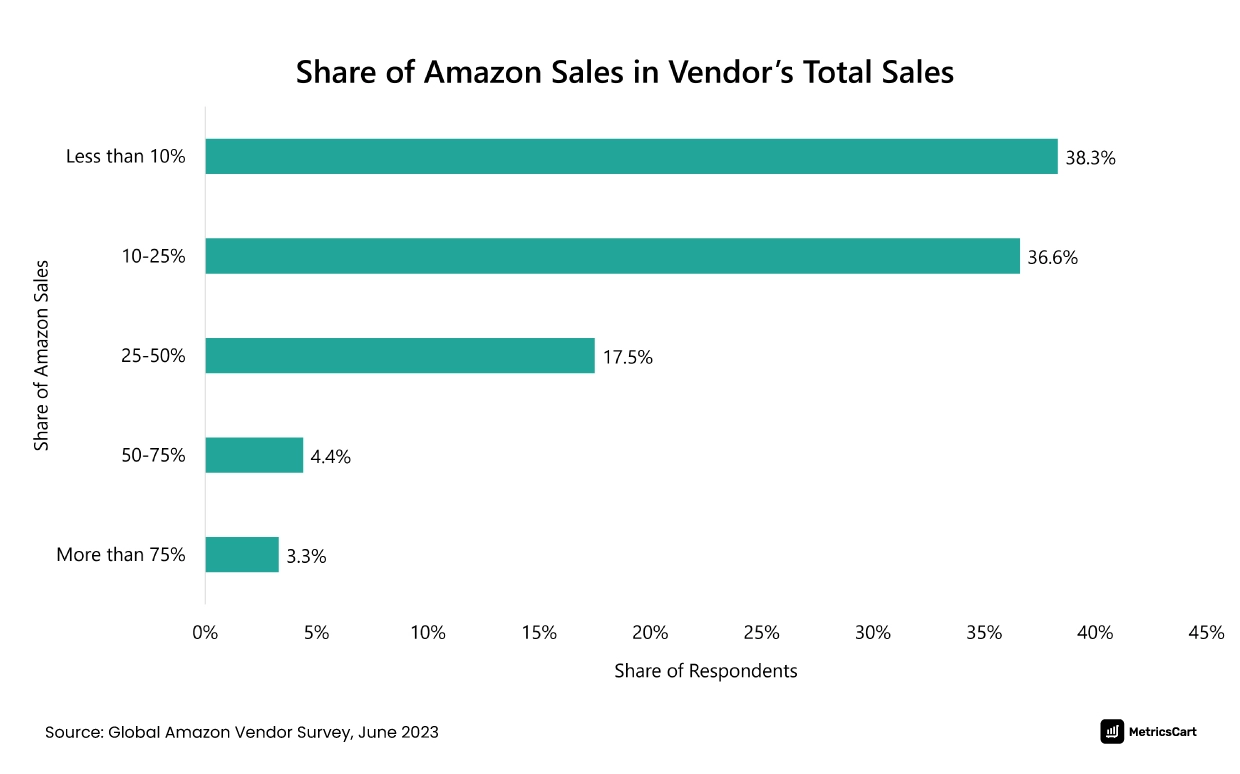
On the other hand, 38.3% of the vendors keep it less than 10%.
What Are the Top Priorities of 1P Relationships on Amazon?
The same survey shows that process automation, launching exclusive Amazon products, and setting a hybrid seller approach are the biggest focus areas among 1P vendors.
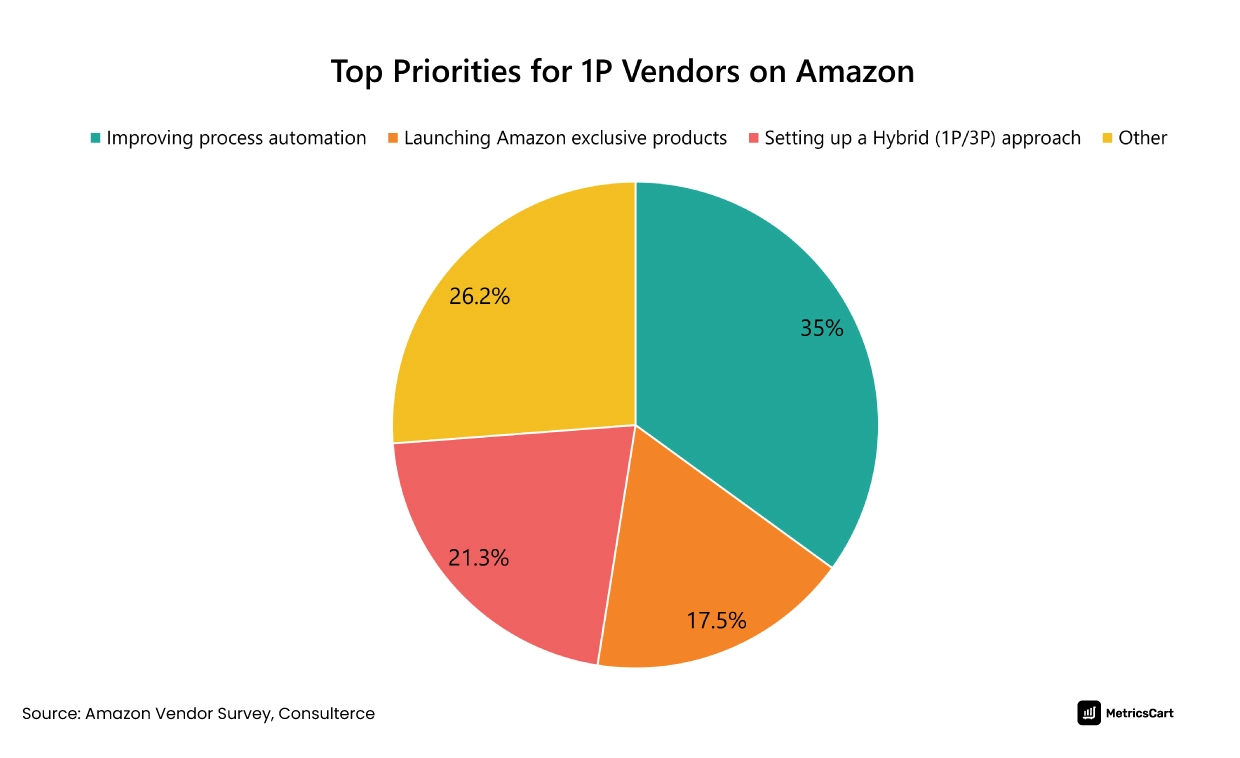
According to the survey, vendors are looking to free their teams from manual efforts and automate repetitive tasks. These automation efforts span logistics, customer service, operations, and marketing.
Now that we know what Vendor Central and 1P relationship with Amazon looks like, let’s look at the pros and cons of Amazon 1P.
Pros
- Access to Amazon Retail Analytics (ARA): Vendors get access to Amazon Retail Analytics with a Vendor Central dashboard. There is a Basic and Premium version of ARA. ARA Basic provides reports on sales and inventory, demand, catalog, and operations. ARA Premium provides additional reports on:
- Customer Behavior
- Sales
- Geographic Performance
- Operations
- Market Trends
- Customer Reviews
Amazon’s Vendor Premium Services starts at approximately $30k/year.
- Prime eligibility: Products under 1P are automatically eligible for Prime perks such as free two-day shipping. IP listings also have a higher likelihood of featured search results (SERPS), and product display ads on product pages. Third-party sellers may also qualify for Prime, but it is a longer process through Seller Fulfilled Prime or Fulfillment By Amazon.
- Direct relationship with Amazon: As a 1P, the vendor has more control over branding since Amazon is essentially acting as a retailer rather than a marketplace. This is a direct relationship and the products are listed as shipped and sold by Amazon. This may help to build customer loyalty and lead to higher conversion.
- Ease of inventory management: Regular and large purchase orders (POs) from Amazon simplify inventory management. It is more cost-effective for most businesses to fulfill wholesale orders rather than to ship individual D2C orders. Most of the responsibility and cost associated with managing and storing inventory is no longer the business’s priority.
- Consolidated fee structure: 1P sellers do not have to consider per-item fee calculations, compute and collect sales tax on a per-order basis, manage listings, reprice products, or process returns. This is mainly because Amazon bought the items from the vendor and is now accountable for all sorts of fees. Moreover, Amazon charges 1P sellers certain fees, but they are usually less varied and cumbersome than those charged to 3P sellers.
- Amazon handles shipping and customer service: This could be a major benefit for brands that don’t have the resources to handle these services on their own.
Cons
- Low profit margins: Amazon 1P has lower profit margins than 3P sellers as Amazon takes a cut from the sales price. For instance, if the retail price of the unit is $150, then Amazon may pay the vendor $120 for the unit, which is the wholesale rate.
- Less control over inventory: As a 1P seller, the vendor has limited control over inventory since they are selling to Amazon, not to the end customers. Additionally, even though Amazon has more control over selling the brand’s products, the brand still needs to monitor and track inbound shipments to Amazon.
This also includes ensuring that inventory levels are sufficient to meet demand and that the products are shipped to Amazon on time. Chargebacks may result from noncompliance with POs.
The vendor’s inventory is entirely dependent on the POs.
- Slow payment process: The payment for 1P sellers could be between 30, 60, or 90 days. This could impact the seller’s cash flow. Moreover, even though Amazon has more control over the brand, it doesn’t mean the product will be a best seller or will have higher sales.
- Less control over pricing: Amazon fixes the price for 1P sales, though Amazon negotiates the minimum advertised price (MAP) with the brand, it may still sell the product below MAP. This may lead to breaking the brand’s minimum advertised price (MAP) policy. Moreover, Amazon pricing may limit the brand’s potential to sell on other online marketplaces.
- Higher costs: IP sellers may be required to incur a higher cost taking into consideration the following costs for selling on Amazon:
- Wholesale/Pure Profit Margin (PPM)
- Net Pure Profit Margin (Net PPM)
- Operating Margin, including shortage claims, Average Vendor Negotiations (AVN), etc.
- Off Amazon P&L Costs, including MAP, data providers, agency fees, etc.
- Miscellaneous Costs
- Risk of lost sales: Amazon decides which products to carry and how much to order. For brands selling via 1P, there is a risk of lost sales if Amazon decides to lessen or stop ordering from the brand for various reasons.
What is Amazon 3P?
A third-party Amazon seller is one who sells products directly to consumers on the Amazon marketplace. In Amazon’s 3P model, the seller maintains control of the product and pricing.
What Are the Order Fulfillment Options for 3P Sellers?
The various fulfillment options include Fulfillment by Amazon (FBA), Fulfillment by Merchant (FBM), or Seller Fulfilled Prime (SFP).
Fulfillment by Amazon
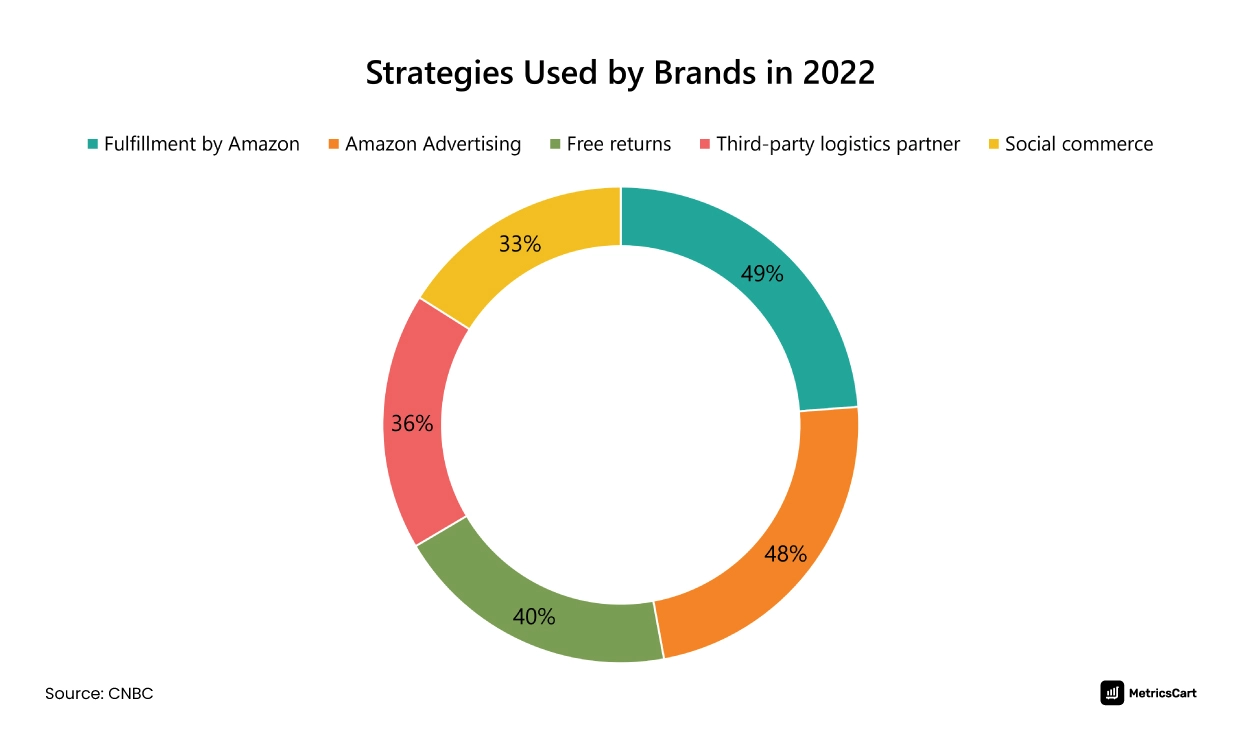
In FBA, Amazon takes care of picking, packing, shipping, and returns. FBA is one of the most-used strategies by brands in 2022. This fulfillment option offers a suite of tools and reports to help e-commerce businesses and entrepreneurs track inventory in Amazon’s warehouses.
Merchant Fulfilled Network or Fulfillment by Merchant
Amazon terms Fulfillment by Merchant as Merchant Fulfilled Network (MFN). In this method of selling, sellers list products on Amazon but manage all storage, shipping, and customer support by themselves.
Seller Fulfilled Prime
In Seller Fulfilled Prime, sellers can deliver directly to Prime customers from their own warehouses.
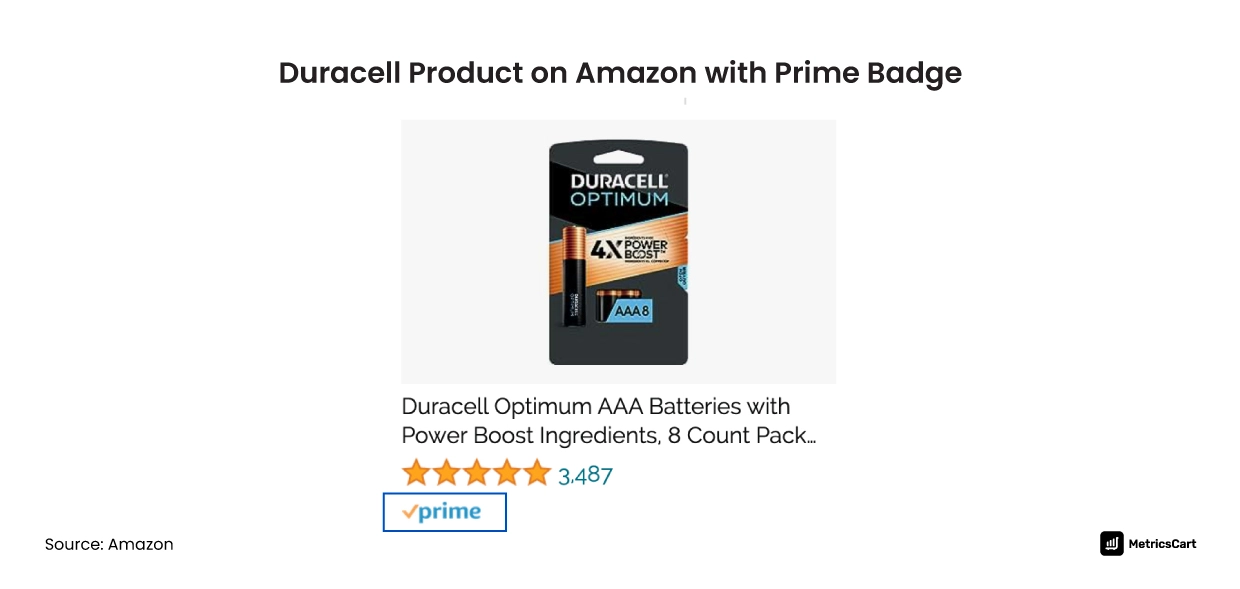
With the Prime badge, the orders are fulfilled with One-Day and Two-Day Delivery at no additional cost for Prime members. There is access to transportation solutions from Amazon. This helps sellers to set the bar high for the Prime customer experience.
How Does Amazon Seller Central Work?
Amazon Seller Central is available for all sellers on Amazon by creating a seller account. Based on the business’s selling goals, an Individual or a Professional selling plan can be chosen. In 2019, Amazon launched 225 new tools and services to help 3P sellers. Amazon’s Seller University has all resources to help brands, entrepreneurs, and businesses alike to be on top of their e-commerce game.
The Seller Central dashboard allows brands and sellers to:
- Create product detail pages
- Manage and monitor inventory levels
- View the status of your orders
- Adjust your pricing
- Get an overview of account health
Share of paid units sold by Amazon 3P sellers has spiked up to 59% in the first quarter of 2023.
How To Identify Amazon 3P?
Products sold via 1P will have a “Ships from” and “sold by” Amazon.com label on the brand’s product detail page.

As seen in the example, COSRX sells its products on Amazon as a third-party seller. COSRX Snail Mucin 96% Power Repairing Essence Hydrating Serum for Face is one of the bestselling products on Amazon, as per MetricsCart Amazon Bestseller reports.
What Is the Share of Paid Units Sold by 3P Sellers on Amazon Over a Decade?
Back in Q2 2013, the share of paid units sold by 3P sellers on Amazon was at 40%. This has jumped up to 59% in the first quarter of 2023.
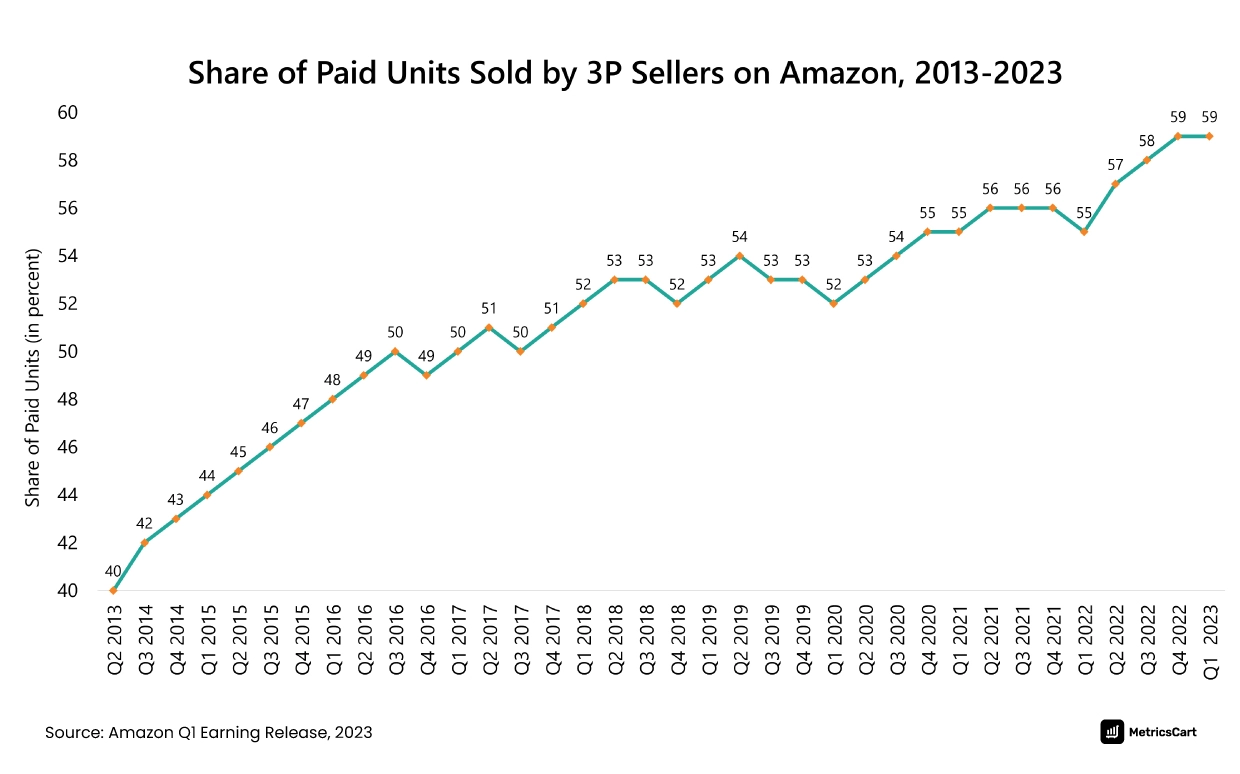
The year-over-year increase in the first quarter of 2022 to 2023 is 7%.
Read more: Amazon Pricing Strategy: How critical is it for profitability?
Now that we know what Seller Central and the 3P relationship with Amazon look like, let’s look at the pros and cons of Amazon 3P.
Pros
- Control over product pricing: 3P sellers have the advantage of making price adjustments as per Amazon’s terms and services. This enables the brand to price the products in real-time against competitors. The price rationalization structure across channels makes it possible for higher profit margins. Moreover, this eliminates the issue of selling products below the MAP agreements.
- Well-optimized product listings: Being able to present your brand, and products, and control the overall customer experience is one of the biggest advantages of 3P sellers. The brands can control their listings, promotions, and the number of units to sell. They can update their product pages at any time. This offers 3P sellers better product launch capabilities than the 1P sales model.
- Inventory flexibility: 3P sellers have greater visibility of their inventory when they manage their own inventory. The sellers would know when it is time to restock, ship and pack. They could either rely on a third-party logistics (3PL) provider such as Fulfillment by Amazon. Sellers can also back up their inventory management with advanced data analytics such as Amazon Brand Analytics.
- Faster payments: Amazon makes payments to 3P sellers every 2 weeks. In contrast, 1P vendors can wait up to 3 months (90 days) for their Amazon POs to be paid. This stabilizes the cash flows for e-commerce businesses.
- Greater control over the brand: 3P sellers have better options on their catalog, inventory, product information, and brand visibility. Most importantly, it helps sellers protect their brand against bad listings through Brand Registry. Under Brand Registry, the brand just needs to provide information about their brand to Amazon so the platform will take steps for:
- Automated Protection
- Reporting Violations
- Patent Evaluation, and more.
- Better access to data: In 2021, Amazon opened up more data to third-party sellers with a new tool called Product Opportunity Explorer. This tool provides Amazon sellers insight into Amazon customer search and purchase behavior. It can be used to identify unmet customer demand and opportunities for new products.
Cons
- Inventory challenges: All the inventory logistics have to be handled by the third-party seller. Amazon Marketplace Sellers cannot let their inventory sit for too long without selling especially when they use FBA. To align with Amazon’s own same-day, one-day, and two-day shipping offerings, the brand will have to streamline its supply chains to be able to get items in and out quickly. Moreover, overselling and out-of-stocks can result in strikes against the brand’s account. In a repeated scenario, Amazon may even suspend or remove the seller’s account completely.
- Additional fees: Brands are subjected to various marketplace fees such as referral fees, fulfillment fees, and shipping fees depending on the seller plan chosen. These fees may be comparatively more predictable than Vendor Central but they can still be high when using FBA.
- Full responsibility for marketing and customer service: The brand is largely on its own to manage all the marketing and customer service. This may be a challenge for 3P sellers new to Amazon Marketplace. The seller needs to be well-versed in optimizing product listings, winning the Buy Box (now called Featured Offer), and running ad campaigns. Moreover, 3P sellers need to respond to customer inquiries and process returns.
Quick Summary of Amazon 1P vs. 3P
Here’s a comparison of Amazon 1P and 3P based on different features:
| Feature | Amazon Vendor Central (1P) | Amazon Seller Central (3P) |
|---|---|---|
| Access | Invite-only | Open to All |
| User | Distributor or Manufacturer | Seller or Retailer |
| Customer | Amazon | Amazon Shoppers |
| Cost | Variable | Fixed |
| Pricing | Set by Amazon | Set by Seller |
| Profit Margins | Wholesale Margin | Retail Margin |
| Payment | Net 90 | Every 7-14 days |
| Inventory Management | Distributor and Amazon | Seller and Amazon |
| Warehouse | Amazon | Amazon or Seller |
| Order Fulfilment | Amazon | Seller or Amazon |
| Customer Service | Amazon | Seller or Amazon |
| Winning Featured Offer (formerly called Amazon Buy Box) | Higher at Same Price | Lower at Same Price unless Seller Fulfilled Prime |
| Marketing | A+ Enhanced Marketing Content, Amazon Vine | Enhanced Brand Content, Early Amazon Reviewer Program |
| Support | Dedicated Account manager | Seller Support |
| Fees | Marketing, Remittance, Co-op, Packaging and Others | $0.99 to $39.99/Month Along With Referral and Variable Closing Fees |
Deciding on the Amazon seller relationship that suits a business depends on the brand’s online marketplace distribution strategy. This distribution strategy should align with the key brand metrics. However, there is a no-one-size-fits-all approach to selling on Amazon. The sellers may also think to opt for a hybrid sales approach.
Hybrid Approach to Selling on Amazon
“Hybrid” is a mix of 1P vendors and 3P sellers. While Vendor Central is a hands-off model and 3P gives better control, the hybrid model helps solve the dilemma of vendors who want to enjoy the benefits both models offer. The hybrid selling model can help with common challenges when selling on Amazon:
- Control over pricing
- Inventory management
- Profit-making product launches
- Easier product listing options
- Less risk of lost sales
- Better cash flow
- Access to more data tools

With a hybrid approach, the features of 1P complement the features of 3P. A Feedvisor report shows that 53% of sellers on Amazon are both first-party and third-party.
In contrast, the wider difference between first-party and third-party sellers means that more brands care about product listings, promotions, and advertising on Amazon than about control of pricing.
Digital Shelf Insights for Amazon Profitability
Access to robust digital shelf analytics solutions helps brands selling on Amazon to:
- Improve their omnichannel marketing efforts
- Perform thorough marketplace analysis along with current performance evaluation
- Track and optimize your paid or organic campaigns
- Get hourly and daily data insights for informed decision-making
- Free their teams from the manual effort
At MetricsCart, we have got you covered with all of it! Brands are able to personalize traffic dashboards, monitor spending on advertising campaigns, and access additional reports that allow them to build competitive shelf intelligence. MetricsCart’s Amazon Bestseller Reports across brands and categories are another treasure trove of freely accessible data for brands and retailers alike.
Get in touch with our team of experts.




